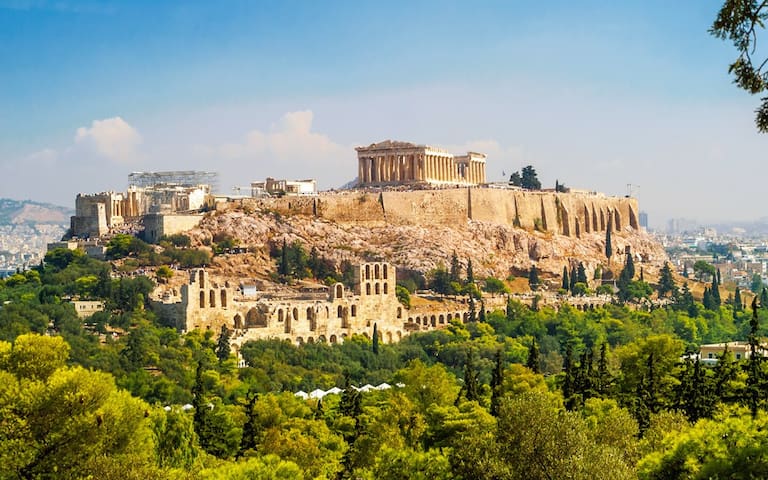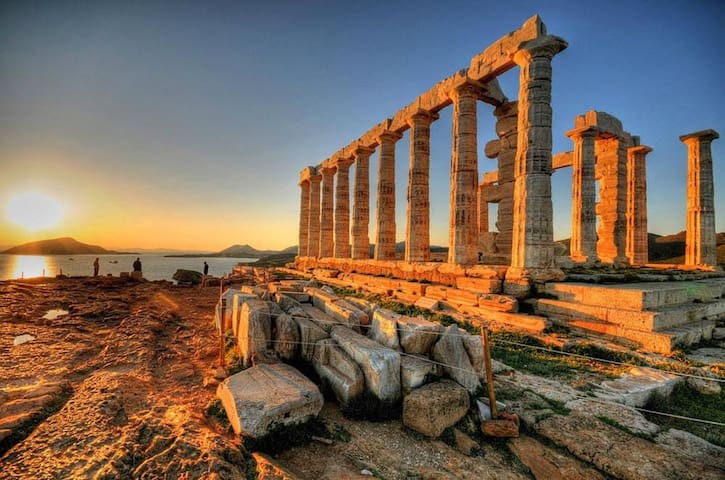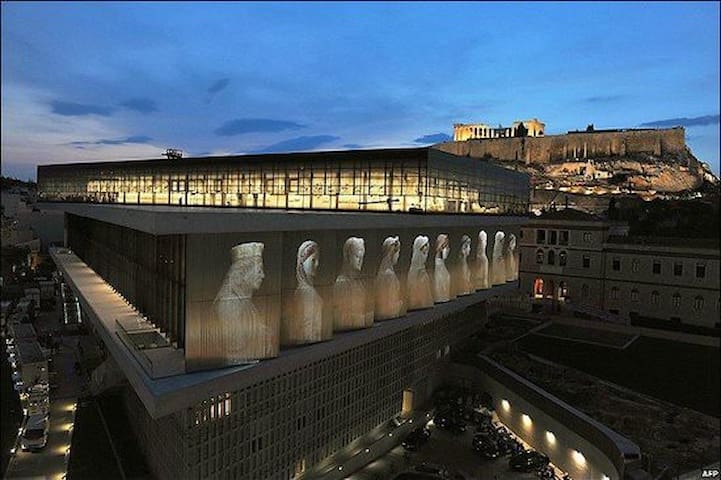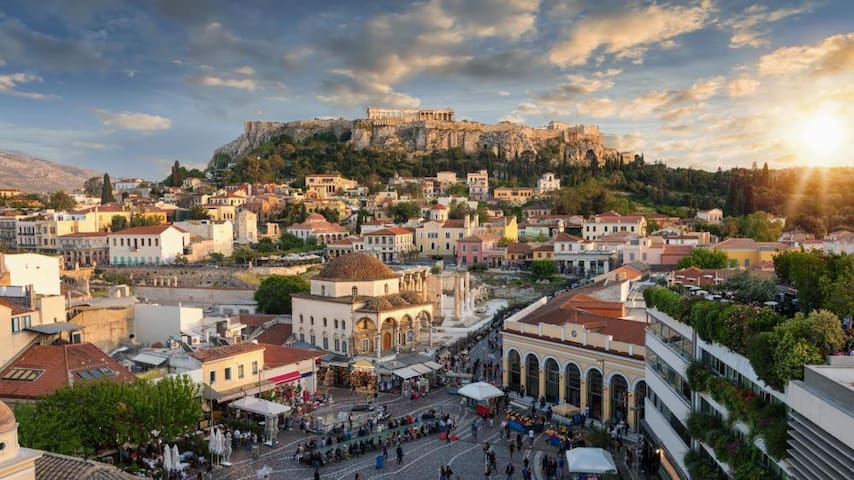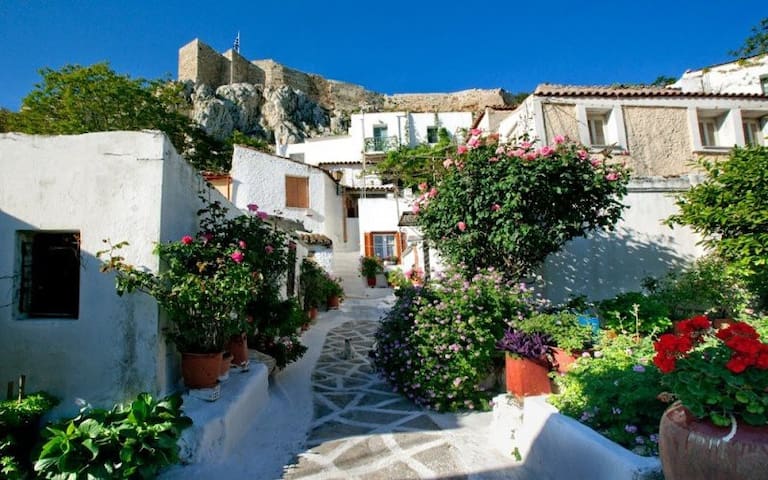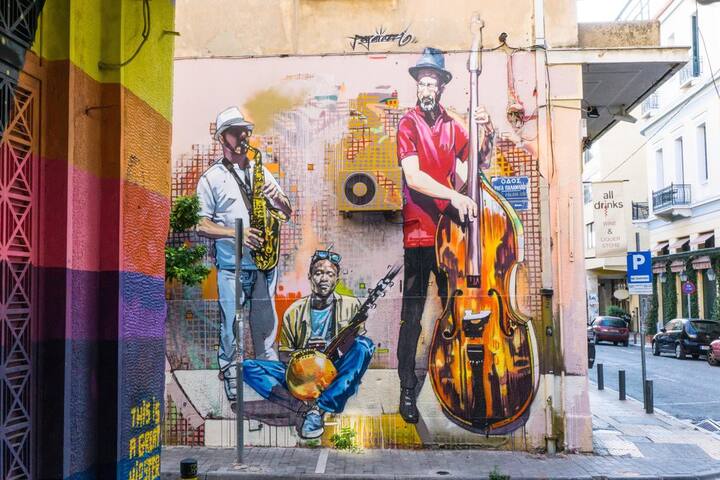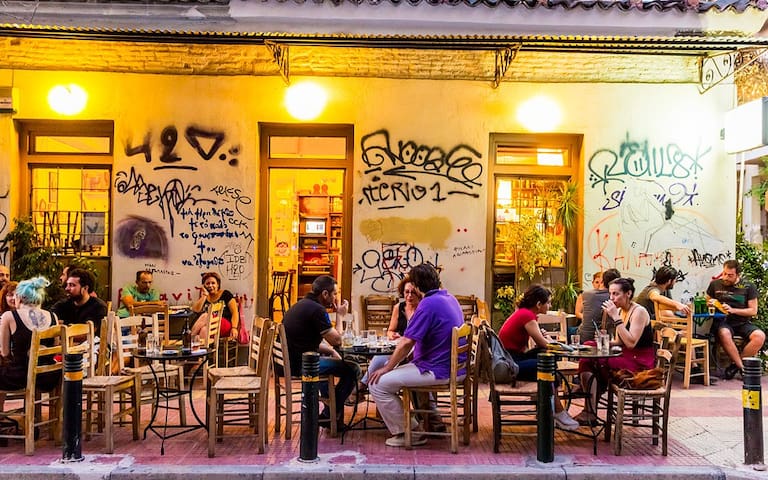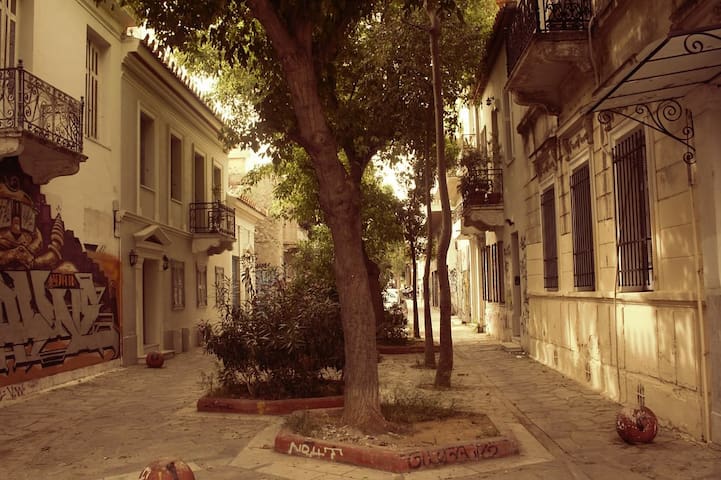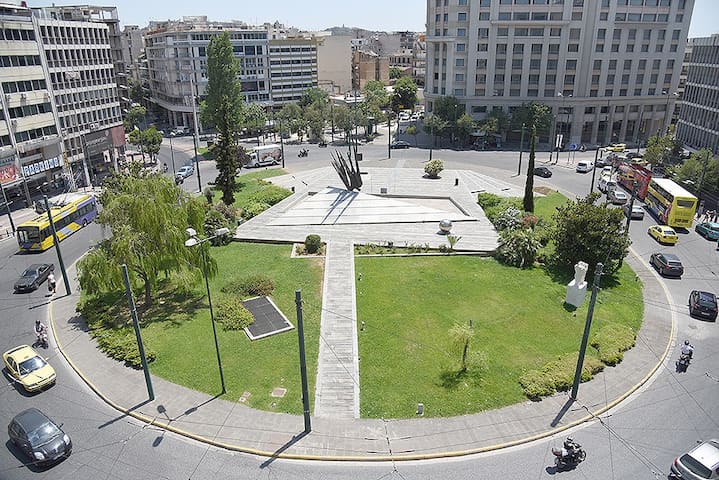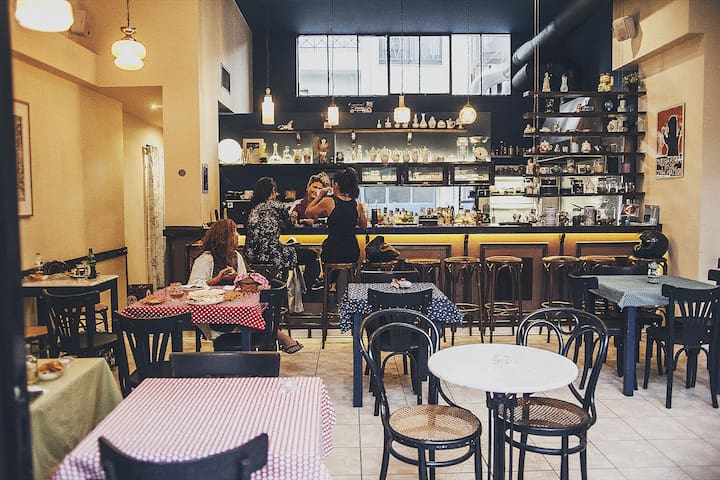Sightseeing
The largest and finest sanctuary of ancient Athens, dedicated primarily to its patron, the goddess Athena, dominates the center of the modern city from rocky crag known as the Acropolis. The most celebrated myths of ancient Athens, its greatest religious festivals, the earliest cults and several decisive events in the city's history are all linked to this sacred precinct. The monuments of the Acropolis stand in harmony with their natural setting. These unique masterpieces of ancient architecture combine different orders and styles of Classical art in the most innovative way and have influenced art and culture for many centuries. The Acropolis of the fifth century BC is the most accurate reflection of the splendor, power and wealth of Athens at its greatest peak, the golden age of Pericles.
From the 1st of September the Site’s time schedule will be as follows: 1.09-15.09.2019: 8:00-19:30, 16.09-30.09.2019: 8:00-19:00, 1.10-15.10.2019: 8:00-18:30, 16.10-31.10.2019: 8:00-18:00
1 January: closed
25 March: closed
1 May: closed
Easter Sunday: closed
25 December: closed
26 December: closed
Stand in the rock next to the entrance of Acropolis and watch a marvelous sunset and a great view of the city of Athens. Stand in the rock next to the entrance of Acropolis and watch a marvelous sunset and a great view of the city of Athens. Prepare for a slippery ground so it's better if you wear sport shoes.
1856 íbúar mæla með
Atenas Akropolis
The largest and finest sanctuary of ancient Athens, dedicated primarily to its patron, the goddess Athena, dominates the center of the modern city from rocky crag known as the Acropolis. The most celebrated myths of ancient Athens, its greatest religious festivals, the earliest cults and several decisive events in the city's history are all linked to this sacred precinct. The monuments of the Acropolis stand in harmony with their natural setting. These unique masterpieces of ancient architecture combine different orders and styles of Classical art in the most innovative way and have influenced art and culture for many centuries. The Acropolis of the fifth century BC is the most accurate reflection of the splendor, power and wealth of Athens at its greatest peak, the golden age of Pericles.
From the 1st of September the Site’s time schedule will be as follows: 1.09-15.09.2019: 8:00-19:30, 16.09-30.09.2019: 8:00-19:00, 1.10-15.10.2019: 8:00-18:30, 16.10-31.10.2019: 8:00-18:00
1 January: closed
25 March: closed
1 May: closed
Easter Sunday: closed
25 December: closed
26 December: closed
Stand in the rock next to the entrance of Acropolis and watch a marvelous sunset and a great view of the city of Athens. Stand in the rock next to the entrance of Acropolis and watch a marvelous sunset and a great view of the city of Athens. Prepare for a slippery ground so it's better if you wear sport shoes.
Majestic Cape Sounion, a strategic point rising above the Aegean sea about 70 kilometers away from Athens in the southern region of Attica, was known by Ancient Greeks as the “Sacred Cape.” On top of this 60 meter cliff stands one of the most important sanctuaries in the region: the temple dedicated to Poseidon, God of the Sea.
As with many other monuments and sanctuaries around Greece, historical facts about the Temple of Poseidon in Sounion are intertwined with bits of legend. It is thought to be the spot where Athenian King Aegeus killed himself by jumping off the cliff. Aegeus, who had positioned himself at Sounion to look out for the return of his son Theseus from Crete, saw the black sails on the ship and mistakenly thought Theseus had been killed by the Minotaur, a creature with the head of a bull and the body of a man. In fact, young Theseus was victorious but had forgotten to replace the black sails on his ship with white ones upon returning, which ultimately led to his father’s death. And so, in commemoration, Aegeus’ name was given to the Aegean Sea.
In Greek mythology, Poseidon, brother of Zeus, was the God of the Sea, so it is no wonder that he was highly revered and worshipped in a country with over 13,500 kilometers of coastline. Ancient Greeks, especially seamen, believed storms were signs of Poseidon’s wrath, and therefore the temple at Cape Sounion was a sacred place where sailors and the general population came to offer animal sacrifices and other gifts to appease him and find favor.
Today, a morning visit to the temple is an excellent day trip option that allows visitors to enjoy lunch at the nearby tavernas and a swim in the afternoon.
Alternatively, you should know that the views of the sunset from the temple’s ruins are considered one of the best sights in all of Greece.
KTEL runs frequent buses from the Mavromateon Terminal in Athens; the buses also stop near Syntagma. The ride along the coast road takes about two hours.
Opening hours
Mon-Sun
Summer- 8:00am – Sunset
Winter- 9:30am – Sunset
474 íbúar mæla með
Hof Poseidon - Sounio
Majestic Cape Sounion, a strategic point rising above the Aegean sea about 70 kilometers away from Athens in the southern region of Attica, was known by Ancient Greeks as the “Sacred Cape.” On top of this 60 meter cliff stands one of the most important sanctuaries in the region: the temple dedicated to Poseidon, God of the Sea.
As with many other monuments and sanctuaries around Greece, historical facts about the Temple of Poseidon in Sounion are intertwined with bits of legend. It is thought to be the spot where Athenian King Aegeus killed himself by jumping off the cliff. Aegeus, who had positioned himself at Sounion to look out for the return of his son Theseus from Crete, saw the black sails on the ship and mistakenly thought Theseus had been killed by the Minotaur, a creature with the head of a bull and the body of a man. In fact, young Theseus was victorious but had forgotten to replace the black sails on his ship with white ones upon returning, which ultimately led to his father’s death. And so, in commemoration, Aegeus’ name was given to the Aegean Sea.
In Greek mythology, Poseidon, brother of Zeus, was the God of the Sea, so it is no wonder that he was highly revered and worshipped in a country with over 13,500 kilometers of coastline. Ancient Greeks, especially seamen, believed storms were signs of Poseidon’s wrath, and therefore the temple at Cape Sounion was a sacred place where sailors and the general population came to offer animal sacrifices and other gifts to appease him and find favor.
Today, a morning visit to the temple is an excellent day trip option that allows visitors to enjoy lunch at the nearby tavernas and a swim in the afternoon.
Alternatively, you should know that the views of the sunset from the temple’s ruins are considered one of the best sights in all of Greece.
KTEL runs frequent buses from the Mavromateon Terminal in Athens; the buses also stop near Syntagma. The ride along the coast road takes about two hours.
Opening hours
Mon-Sun
Summer- 8:00am – Sunset
Winter- 9:30am – Sunset
Museums
the new Acropolis Museum has a total area of 25,000 square meters, with exhibition space of over 14,000 square meters, ten times more than that of the old museum on the Hill of the Acropolis. The new Museum offers all the amenities expected in an international museum of the 21st century.
After crossing the ground floor lobby towards the turn styles of the Museum, the first collection lies before the visitor. An ascending, wide glass-floored gallery houses finds from the slopes of the Acropolis. The occasionally transparent floor provides a view of the archaeological excavation, while its upward slope alludes to the ascent to the Acropolis.
The Gallery of the Slopes of the Acropolis houses finds from the sanctuaries that were founded on the slopes of the Acropolis, as well as objects that Athenians used in everyday life from all historic periods. On the left hand side, finds from some of the key sanctuaries of the slopes are exhibited. On the right hand side, finds from the smaller sanctuaries and settlements that developed on the slopes of the Hill are displayed. In antiquity, the slopes of the Sacred Rock constituted the transition zone between the city and its most famous sanctuary. This was the area where official and popular cults, as well as large and small sanctuaries existed alongside private houses.
An ancient Athenian neighbourhood is incorporated in a unique way in the Acropolis Museum architecture as yet another exhibit which converses with the masterpieces of the ancient Greek civilization presented in its galleries. Nesting on the gentle south slope of the rock, it houses life and human activities from the 4th millennium BC until the 12th cent. AD. Streets, residences, baths, workshops and tombs compose the complex image of archaeological remains. Amongst them those of late antiquity are the best preserved.
Summer season hours (1 April - 31 October)
Monday 8:00 a.m. - 4:00 p.m. (last admission: 3:30 p.m.)
Tuesday - Sunday 8:00 a.m. - 8:00 p.m. (last admission: 7:30 p.m.)
Friday 8:00 a.m. - 10:00 p.m. (last admission: 9:30 p.m.)
Winter season hours (1 November - 31 March)
Monday - Thursday 9:00 a.m. - 5:00 p.m. (last admission: 4:30 p.m.)
Friday 9:00 a.m. - 10:00 p.m. (last admission: 9:30 p.m.)
Saturday - Sunday 9:00 a.m. - 8:00 p.m. (last admission: 7:30 p.m.)
2190 íbúar mæla með
Akropolis Museum
15 Dionysiou Areopagitouthe new Acropolis Museum has a total area of 25,000 square meters, with exhibition space of over 14,000 square meters, ten times more than that of the old museum on the Hill of the Acropolis. The new Museum offers all the amenities expected in an international museum of the 21st century.
After crossing the ground floor lobby towards the turn styles of the Museum, the first collection lies before the visitor. An ascending, wide glass-floored gallery houses finds from the slopes of the Acropolis. The occasionally transparent floor provides a view of the archaeological excavation, while its upward slope alludes to the ascent to the Acropolis.
The Gallery of the Slopes of the Acropolis houses finds from the sanctuaries that were founded on the slopes of the Acropolis, as well as objects that Athenians used in everyday life from all historic periods. On the left hand side, finds from some of the key sanctuaries of the slopes are exhibited. On the right hand side, finds from the smaller sanctuaries and settlements that developed on the slopes of the Hill are displayed. In antiquity, the slopes of the Sacred Rock constituted the transition zone between the city and its most famous sanctuary. This was the area where official and popular cults, as well as large and small sanctuaries existed alongside private houses.
An ancient Athenian neighbourhood is incorporated in a unique way in the Acropolis Museum architecture as yet another exhibit which converses with the masterpieces of the ancient Greek civilization presented in its galleries. Nesting on the gentle south slope of the rock, it houses life and human activities from the 4th millennium BC until the 12th cent. AD. Streets, residences, baths, workshops and tombs compose the complex image of archaeological remains. Amongst them those of late antiquity are the best preserved.
Summer season hours (1 April - 31 October)
Monday 8:00 a.m. - 4:00 p.m. (last admission: 3:30 p.m.)
Tuesday - Sunday 8:00 a.m. - 8:00 p.m. (last admission: 7:30 p.m.)
Friday 8:00 a.m. - 10:00 p.m. (last admission: 9:30 p.m.)
Winter season hours (1 November - 31 March)
Monday - Thursday 9:00 a.m. - 5:00 p.m. (last admission: 4:30 p.m.)
Friday 9:00 a.m. - 10:00 p.m. (last admission: 9:30 p.m.)
Saturday - Sunday 9:00 a.m. - 8:00 p.m. (last admission: 7:30 p.m.)
Spectacular view
Standing 277 meters above sea level, Lycabettus Hill (sometimes spelt Lykavitos) is the highest point of Athens. Although a beautiful walk up via a circular path, it will be a test of endurance and a challenge in summer.
A funicular or cliff railway can take you to the top of the hill and proves to be a novelty for younger kids. The downside is it moves inside a closed tunnel, so there is no view on the way up or down.
The view from Lycabettus Hill is best enjoyed at sunset whilst waiting for the lights of the Acropolis, Temple of Olympian Zeus, Panathenaic Stadium and Ancient Agora to come on. You will also be reminded that Athens is surrounded by sea with spectacular views across the Aegean.
At the top of the hill you will find the Greek whitewashed church of Agios Georgios (St. George) and all are welcome to enter. The viewing platform in front of the church provides sprawling views of Athens, stretching out to the city’s coastline. A cafe is open for breakfast and lunch. Dinner reservations can be made at the very upscale Orizontes restaurant, that also has spectacular views across Athens.
Arrive in time for sunset
Lycabettus Hill is located in the suburb of Kolonaki and is a great area to explore before or after your visit here
If you decide to take a taxi, it can only take you so far up the hill. You will need to walk up a significant amount of stairs for the remainder of the way
265 íbúar mæla með
Lycabettus-hæðin
LikavittouStanding 277 meters above sea level, Lycabettus Hill (sometimes spelt Lykavitos) is the highest point of Athens. Although a beautiful walk up via a circular path, it will be a test of endurance and a challenge in summer.
A funicular or cliff railway can take you to the top of the hill and proves to be a novelty for younger kids. The downside is it moves inside a closed tunnel, so there is no view on the way up or down.
The view from Lycabettus Hill is best enjoyed at sunset whilst waiting for the lights of the Acropolis, Temple of Olympian Zeus, Panathenaic Stadium and Ancient Agora to come on. You will also be reminded that Athens is surrounded by sea with spectacular views across the Aegean.
At the top of the hill you will find the Greek whitewashed church of Agios Georgios (St. George) and all are welcome to enter. The viewing platform in front of the church provides sprawling views of Athens, stretching out to the city’s coastline. A cafe is open for breakfast and lunch. Dinner reservations can be made at the very upscale Orizontes restaurant, that also has spectacular views across Athens.
Arrive in time for sunset
Lycabettus Hill is located in the suburb of Kolonaki and is a great area to explore before or after your visit here
If you decide to take a taxi, it can only take you so far up the hill. You will need to walk up a significant amount of stairs for the remainder of the way
Neighborhoods
There aren’t many places which showcase so perfectly the multi-layered mix of cultures which we call Greek civilization, like Monastiraki square. It is situated north of Plaka, the traditional neighborhood under the Acropolis, and right next to the busy junction of two central streets, Ermou and Athinas.
Standing in the middle of the square and looking around, you immediately perceive the diversity of the buildings which are visible. On one side you have the Ottoman-era mosque of Tzistarakis and on the other, the orthodox church of the “Dormition of the Virgin Mary of Athens”. The pillars of Hadrian’s Library, built in the 2nd century A.D., can be seen through and next to the arches of the Mosque, while – directly above them – the imposing Acropolis dominates the backdrop. Several neoclassical buildings which surround the square or line Athinas street, including the Metro Station, add yet another era to the list of the ones already represented in this limited space. In other words, you are standing in the middle of a miniature architectural representation of the melting pot of cultures that have passed from this land, which stands on the crossroads of three continents.
Monastirakis' shops
Despite the imposing historic buildings, the modern city still manages to shout its presence through the noise that comes from the busy shops and the people who crowd the square on a daily basis. Here you can find souvlaki places and Greek taverns, traditional “kafeneio” and modern cafés, Chinese-made souvenirs next to genuine Greek art pieces and shops that sell both real antiques of all kinds, as well as cheap imitations or even cheesy, fake ancient Greek hoplite helmets. Peddlers of various foods and snacks compete for premium spots and fill the air with smells of roasted chestnuts or fresh, pungent fruit, depending on the season. On one corner you might find youngsters beat-boxing and break-dancing, while on another, the sound of bouzouki from a tavern’s resident band tempts passers-by to start dancing the Zorba. Every other day a different street-performance act takes place and countless roaming buskers pass from here, covering all styles of music, from folk to jazz.
Another characteristic feature of Monastiraki is the antiques- and flea- market which operates in the streets around and including Ermou and Ifestou and on Abyssinia square. Ages-old army surplus stores filled with all kinds of second-hand equipment, along with relics like old swords and broken guns, Nazi helmets and old war-medals of various kinds have been waiting here for as long I can remember.
The range of things which can be sold or bought here is impressively wide; old books and magazines, vinyl records and cd’s, furniture, hand-made musical instruments of all kinds, leather bags or sandals, trendy clothing, souvenirs, collectibles and many more things you don’t really need – but possibly want to own – can keep you browsing for hours. Just don’t buy that “This is Sparta!” t-shirt, because you know my friend, this is not Sparta. To be accurate this is the exact opposite of Sparta… this is Athens!
All in all, Monastiraki is one of few places in Athens that manages to convey this eternal city’s complex and multi-faceted character, as it encompasses social, gastronomic and historic elements in a generous bouquet that extends chronologically back to the ancient times.
841 íbúar mæla með
Monastiraki
There aren’t many places which showcase so perfectly the multi-layered mix of cultures which we call Greek civilization, like Monastiraki square. It is situated north of Plaka, the traditional neighborhood under the Acropolis, and right next to the busy junction of two central streets, Ermou and Athinas.
Standing in the middle of the square and looking around, you immediately perceive the diversity of the buildings which are visible. On one side you have the Ottoman-era mosque of Tzistarakis and on the other, the orthodox church of the “Dormition of the Virgin Mary of Athens”. The pillars of Hadrian’s Library, built in the 2nd century A.D., can be seen through and next to the arches of the Mosque, while – directly above them – the imposing Acropolis dominates the backdrop. Several neoclassical buildings which surround the square or line Athinas street, including the Metro Station, add yet another era to the list of the ones already represented in this limited space. In other words, you are standing in the middle of a miniature architectural representation of the melting pot of cultures that have passed from this land, which stands on the crossroads of three continents.
Monastirakis' shops
Despite the imposing historic buildings, the modern city still manages to shout its presence through the noise that comes from the busy shops and the people who crowd the square on a daily basis. Here you can find souvlaki places and Greek taverns, traditional “kafeneio” and modern cafés, Chinese-made souvenirs next to genuine Greek art pieces and shops that sell both real antiques of all kinds, as well as cheap imitations or even cheesy, fake ancient Greek hoplite helmets. Peddlers of various foods and snacks compete for premium spots and fill the air with smells of roasted chestnuts or fresh, pungent fruit, depending on the season. On one corner you might find youngsters beat-boxing and break-dancing, while on another, the sound of bouzouki from a tavern’s resident band tempts passers-by to start dancing the Zorba. Every other day a different street-performance act takes place and countless roaming buskers pass from here, covering all styles of music, from folk to jazz.
Another characteristic feature of Monastiraki is the antiques- and flea- market which operates in the streets around and including Ermou and Ifestou and on Abyssinia square. Ages-old army surplus stores filled with all kinds of second-hand equipment, along with relics like old swords and broken guns, Nazi helmets and old war-medals of various kinds have been waiting here for as long I can remember.
The range of things which can be sold or bought here is impressively wide; old books and magazines, vinyl records and cd’s, furniture, hand-made musical instruments of all kinds, leather bags or sandals, trendy clothing, souvenirs, collectibles and many more things you don’t really need – but possibly want to own – can keep you browsing for hours. Just don’t buy that “This is Sparta!” t-shirt, because you know my friend, this is not Sparta. To be accurate this is the exact opposite of Sparta… this is Athens!
All in all, Monastiraki is one of few places in Athens that manages to convey this eternal city’s complex and multi-faceted character, as it encompasses social, gastronomic and historic elements in a generous bouquet that extends chronologically back to the ancient times.
Plaka is without a doubt one of the most picturesque neighborhoods in Athens, with its narrow streets, lovely neoclassical buildings, small cafes, traditional tavernas, souvenir shops and ancient ruins in almost every corner. Plaka is in the heart of the center of Athens, just under the Acropolis hill, yet has a totally different air than the rest of the city center, creating a feeling of nostalgia of the old Athens. Even though it is very commercial and popular with tourists, it is the ideal place to enjoy a nice walk, as there are plenty of things to do and see, while strolling around its small pedestrian streets. In this post, you will find suggestions on how to spend a day and what to do and see in Plaka neighborhood in Athens!
Plaka is considered the area that developed around the ancient Agora of Athens and is the oldest district in Athens, as it has been continuously inhabited for around three thousand years. Thus, Plaka has a long history and has played an important part in Athenian life, with many famous people having walked along its streets, from Pericles and Alexander the Great to Lord Elgin and Lord Byron, while many well-known Greek writers, actors and artists have lived here, like Giorgos Seferis, Kostis Palamas and Melina Merkouri to name a few. When Athens was under the Ottoman rule, Plaka was the known as the "Turkish quarter of Athens" with many historical buildings dating back to this period like the Fethiye Mosque and the Madrasa Islamic school on Pelopida street. During 1884 a large part of Plaka burned down due to a fire, giving the opportunity for extensive archaeological work in the Roman Agora and Hadrian’s library, while excavations in the area have been conducted ever since.
Of course, major part of your visit to Plaka will be archaeology, which will be visible to you as you stroll around. The Roman Agora, built between 19-11 BC as an expansion of the ancient Agora to the East, from donations of Julius Caesar and Augustus, cannot go unnoticeable. There are many interesting structures and buildings in the archaeological site, like the Fethiye Mosque, the Agoranomion and the Tower of the Winds, a 12-meter-tall clocktower designed by the astronomer Andronikos of Cyrrhos, considered the first ever meteorological station, and worked as a sundial, telling the time of the day by the position of the Sun in the sky, a waterclock (with water coming down from the Acropolis) and a wind vane (in antiquity a Triton-shaped weathervane topped the structure). Furthermore, opposite the church of Ayia Aikaterini in Plaka, you can stop by the Choragic Monument of Lysikrates, accessible and free to everyone. Lysikrates was a wealthy patron of theatrical plays performed in the theater of Dionysus. He built this monument to commemorate the first prize he won in 335/334 BC. In 1658 a French Capuchin monastery was built on this site, where Lord Byron also stayed during his second visit to Greece. In 1818 the first tomatoes ever in Greece were planted in the monastery’s garden!
As far as shopping is concerned, Plaka is your souvenir shop paradise. Especially on Adrianou street you will find all kinds of souvenir shops, with Greek local products, jewellery stores, t-shirt shops, you name it. Even though there are also the typical tacky touristic items, you can also find some good quality Greek products and souvenirs, mentioned in our list. In Elaias Gi (Adrianou 122) and Evonon (Adrianou 124) you can find a big selection of good quality Greek olive oil. There is no better tasting extra virgin olive oil than the one produced in Greece, and I am not prejudiced because I am Greek. In these shops you will also find olive tree-based products, like soaps, kitchenware and other nice items. If you want to purchase ouzo, then on Adrianou 120 you will find the shop of Mr. Agelos, who has a huge variety of different brands of ouzo, some of them being difficult to find elsewhere. You will also find many jewellery shops, some of them being artist-owned with stunning handmade pieces, like Byzantino, where they make their own gold jewellery.
1301 íbúar mæla með
Plaka
24 MnisikleousPlaka is without a doubt one of the most picturesque neighborhoods in Athens, with its narrow streets, lovely neoclassical buildings, small cafes, traditional tavernas, souvenir shops and ancient ruins in almost every corner. Plaka is in the heart of the center of Athens, just under the Acropolis hill, yet has a totally different air than the rest of the city center, creating a feeling of nostalgia of the old Athens. Even though it is very commercial and popular with tourists, it is the ideal place to enjoy a nice walk, as there are plenty of things to do and see, while strolling around its small pedestrian streets. In this post, you will find suggestions on how to spend a day and what to do and see in Plaka neighborhood in Athens!
Plaka is considered the area that developed around the ancient Agora of Athens and is the oldest district in Athens, as it has been continuously inhabited for around three thousand years. Thus, Plaka has a long history and has played an important part in Athenian life, with many famous people having walked along its streets, from Pericles and Alexander the Great to Lord Elgin and Lord Byron, while many well-known Greek writers, actors and artists have lived here, like Giorgos Seferis, Kostis Palamas and Melina Merkouri to name a few. When Athens was under the Ottoman rule, Plaka was the known as the "Turkish quarter of Athens" with many historical buildings dating back to this period like the Fethiye Mosque and the Madrasa Islamic school on Pelopida street. During 1884 a large part of Plaka burned down due to a fire, giving the opportunity for extensive archaeological work in the Roman Agora and Hadrian’s library, while excavations in the area have been conducted ever since.
Of course, major part of your visit to Plaka will be archaeology, which will be visible to you as you stroll around. The Roman Agora, built between 19-11 BC as an expansion of the ancient Agora to the East, from donations of Julius Caesar and Augustus, cannot go unnoticeable. There are many interesting structures and buildings in the archaeological site, like the Fethiye Mosque, the Agoranomion and the Tower of the Winds, a 12-meter-tall clocktower designed by the astronomer Andronikos of Cyrrhos, considered the first ever meteorological station, and worked as a sundial, telling the time of the day by the position of the Sun in the sky, a waterclock (with water coming down from the Acropolis) and a wind vane (in antiquity a Triton-shaped weathervane topped the structure). Furthermore, opposite the church of Ayia Aikaterini in Plaka, you can stop by the Choragic Monument of Lysikrates, accessible and free to everyone. Lysikrates was a wealthy patron of theatrical plays performed in the theater of Dionysus. He built this monument to commemorate the first prize he won in 335/334 BC. In 1658 a French Capuchin monastery was built on this site, where Lord Byron also stayed during his second visit to Greece. In 1818 the first tomatoes ever in Greece were planted in the monastery’s garden!
As far as shopping is concerned, Plaka is your souvenir shop paradise. Especially on Adrianou street you will find all kinds of souvenir shops, with Greek local products, jewellery stores, t-shirt shops, you name it. Even though there are also the typical tacky touristic items, you can also find some good quality Greek products and souvenirs, mentioned in our list. In Elaias Gi (Adrianou 122) and Evonon (Adrianou 124) you can find a big selection of good quality Greek olive oil. There is no better tasting extra virgin olive oil than the one produced in Greece, and I am not prejudiced because I am Greek. In these shops you will also find olive tree-based products, like soaps, kitchenware and other nice items. If you want to purchase ouzo, then on Adrianou 120 you will find the shop of Mr. Agelos, who has a huge variety of different brands of ouzo, some of them being difficult to find elsewhere. You will also find many jewellery shops, some of them being artist-owned with stunning handmade pieces, like Byzantino, where they make their own gold jewellery.
An Island Oasis in the Middle of Athens, Greece
Anafiotika is a hidden wonder inside the bustling metropolis that is Athens. It’s hard to believe a place like this even exists–a slice of the Greek Islands that is a veritable oasis amidst city noise, concrete and graffiti.
The architecture is not by accident. Houses in Anafiotika were built in the 1800s by workers who came to Athens from Anafi, an island in the Cyclades, hence the name. They were brought by King Otto to perform renovations on his palace. They captured the essence of this island on their own properties with white walls and Bougainvillea trees.
Since then, the neighborhood has retained a strong sense of pride and aesthetic, especially since many of the residents descend from the original families to arrive in the area. Today, there are 45 of the original houses left.
323 íbúar mæla með
Anafiotika
An Island Oasis in the Middle of Athens, Greece
Anafiotika is a hidden wonder inside the bustling metropolis that is Athens. It’s hard to believe a place like this even exists–a slice of the Greek Islands that is a veritable oasis amidst city noise, concrete and graffiti.
The architecture is not by accident. Houses in Anafiotika were built in the 1800s by workers who came to Athens from Anafi, an island in the Cyclades, hence the name. They were brought by King Otto to perform renovations on his palace. They captured the essence of this island on their own properties with white walls and Bougainvillea trees.
Since then, the neighborhood has retained a strong sense of pride and aesthetic, especially since many of the residents descend from the original families to arrive in the area. Today, there are 45 of the original houses left.
Psyri is a colorful neoclassical neighborhood known for its artisans, specialty stores, restaurants, bars, tavernas with or without live music, theaters, art galleries, antique shops, and a small number of hotels.
Following the liberation of Greece from the Turkish occupation in 1833, several veteran freedom fighters and immigrants from the provinces settled here. They opened cottage industries and workshops, which have given the area a distinctive character. The central square of Psyri is called "Heroes Square" because the streets leading to it carry names of heroes of the Independence War. Another distinguished resident of Psyri was the writer Alexandros Papadiamantis who settled in the area for more than two decades. In the early 1990s, following a series of renovation and construction works, the Psyri neighborhood became a popular nightlife and residential area and it has now become a fair choice in the center of Athens.
464 íbúar mæla með
Psyri
MiaouliPsyri is a colorful neoclassical neighborhood known for its artisans, specialty stores, restaurants, bars, tavernas with or without live music, theaters, art galleries, antique shops, and a small number of hotels.
Following the liberation of Greece from the Turkish occupation in 1833, several veteran freedom fighters and immigrants from the provinces settled here. They opened cottage industries and workshops, which have given the area a distinctive character. The central square of Psyri is called "Heroes Square" because the streets leading to it carry names of heroes of the Independence War. Another distinguished resident of Psyri was the writer Alexandros Papadiamantis who settled in the area for more than two decades. In the early 1990s, following a series of renovation and construction works, the Psyri neighborhood became a popular nightlife and residential area and it has now become a fair choice in the center of Athens.
Greece is known for having the most beautiful beaches in the world and the most quaint villages in Europe, and now the country can add the Athens suburb of Kerameikos — one of the coolest neighborhoods in the world — to the list.
Forbes has announced that the hip, trendy and artistic neighborhood is the place to be if you are looking for cool things to do.
The vibrant neighborhood has murals painted on walls, new exciting restaurants with fusion concepts and is the trendiest place in Athens to have a drink with friends.
The hippie-like atmosphere of the neighborhood has caught on and even tourists check it out and hang out with the local crowds.
There are up-and-coming artists who display their work at galleries, theatres, bars, and there is something do around every corner.
Kerameikos is just a 10 minute walk from the historic center of Athens, and as Forbes puts it: “the laidback Kerameikos neighborhood seems to live in a magical world of its own.”
“It’s a place where old and new, Greece’s storied past and often turbulent present, tradition and forward-looking creativity all coexist happily together. At the weekly street market, the neighborhood comes alive in a riot of sights, smells and flavors. In recent years Kerameikos’s low rents and old-time feel have lured creative young Athenians to the area, where they have opened inventive restaurants, bars and cafés along with galleries and theaters. Joining Kerameikos’s rich trove of existing old-school establishments, these new spots have helped create one of the Athens’ most exciting dining and cultural scenes.”
194 íbúar mæla með
Keramikos
Greece is known for having the most beautiful beaches in the world and the most quaint villages in Europe, and now the country can add the Athens suburb of Kerameikos — one of the coolest neighborhoods in the world — to the list.
Forbes has announced that the hip, trendy and artistic neighborhood is the place to be if you are looking for cool things to do.
The vibrant neighborhood has murals painted on walls, new exciting restaurants with fusion concepts and is the trendiest place in Athens to have a drink with friends.
The hippie-like atmosphere of the neighborhood has caught on and even tourists check it out and hang out with the local crowds.
There are up-and-coming artists who display their work at galleries, theatres, bars, and there is something do around every corner.
Kerameikos is just a 10 minute walk from the historic center of Athens, and as Forbes puts it: “the laidback Kerameikos neighborhood seems to live in a magical world of its own.”
“It’s a place where old and new, Greece’s storied past and often turbulent present, tradition and forward-looking creativity all coexist happily together. At the weekly street market, the neighborhood comes alive in a riot of sights, smells and flavors. In recent years Kerameikos’s low rents and old-time feel have lured creative young Athenians to the area, where they have opened inventive restaurants, bars and cafés along with galleries and theaters. Joining Kerameikos’s rich trove of existing old-school establishments, these new spots have helped create one of the Athens’ most exciting dining and cultural scenes.”
Metaxourgeio, an area in Athens that doesn’t look inviting at first glance, is a district of extremes. Step too close to Omonoia, and you will feel like you’ve just landed in a 1980s New York street. If you venture farther down, you will stumble upon beautiful restored neoclassical mansions and modern loft apartment complexes where a higher-income crowd lives.
However, in the middle, longtime residents and newcomers collide, successfully creating an inviting neighborhood known for its many social initiatives, events, and activities, including the Carnival of Metaxourgeio. Underneath its rough exterior, this district has a lot to offer to visitors and locals alike. Here are the best things to do in Metaxourgeio.
Have some raki
Frequently visited by Athenian youth, Metaxourgeio is not home to mega nightclubs or posh bars. Rather, you will stumble upon countless raki restaurants, where people gather around and order meze and drink liters of the strong drink until they head home. There is no need to dress up; all you have to do is find a table, sit down and drink as much as you can handle. However, don’t be surprised if your bill doesn’t reflect the number of drinks you have had. Metaxourgeio is one of the cheapest areas in Athens, especially when it comes to food and drinks. It’s a win-win!
Immerse yourself in the culture
Home to a few small theaters and music venues, Metaxourgeio is the place to discover the local indie scene or catch a play (most likely in Greek). The area boasts a few live music stages and bars (check out Kerameio where you can score an impromptu performance or visit Passport Kerameikos to see a concert, for example). The Rabbit Hole on Germanikou is an art and performance space where you can catch a theatrical or music performance as well as art exhibitions.
Dine like royals
Emerging as a cool, alternative hub, Metaxourgeio is also home to many eateries and restaurants where you can enjoy local and exotic flavors and dine like a king or queen. For a fine-dining experience, Funky Gourmet will impress you with its elegant and well-thought-out menu. For Greek flavors with a twist, the ever-crowded Seychelles, where bookings are recommended, puts a creative spin on Greek fare with the freshest ingredients. Elvis is the place to go for juicy souvlaki, and Fill The Bracket is a great spot to have a tasty brunch.
Explore the local street art scene
Just like Exarcheia and Psyrri, Metaxourgeio is home to a vibrant street art scene and is a perfect stop to admire some fantastic designs. While not all of them are painted on derelict buildings, a walk across the streets will not only give you a glimpse into the talent of several street artists but also allow you to admire the beauty of this district, which still features a few beautiful neoclassical mansions and buildings.
Party the night away
On the border of Iera Odos stands Lohan nightclub, Lindsay Lohan’s nightlife venue in the Greek capital. Considered one of the top clubs in Athens, Lohan is definitely an excellent place to dance the night away to the sounds of DJ sets. If clubs are not your thing, Metaxourgeio is home to many bars where you can still enjoy an entertaining night, drink delicious cocktails and listen to great music (sometimes even live).
47 íbúar mæla með
Metaxourgeio
Metaxourgeio, an area in Athens that doesn’t look inviting at first glance, is a district of extremes. Step too close to Omonoia, and you will feel like you’ve just landed in a 1980s New York street. If you venture farther down, you will stumble upon beautiful restored neoclassical mansions and modern loft apartment complexes where a higher-income crowd lives.
However, in the middle, longtime residents and newcomers collide, successfully creating an inviting neighborhood known for its many social initiatives, events, and activities, including the Carnival of Metaxourgeio. Underneath its rough exterior, this district has a lot to offer to visitors and locals alike. Here are the best things to do in Metaxourgeio.
Have some raki
Frequently visited by Athenian youth, Metaxourgeio is not home to mega nightclubs or posh bars. Rather, you will stumble upon countless raki restaurants, where people gather around and order meze and drink liters of the strong drink until they head home. There is no need to dress up; all you have to do is find a table, sit down and drink as much as you can handle. However, don’t be surprised if your bill doesn’t reflect the number of drinks you have had. Metaxourgeio is one of the cheapest areas in Athens, especially when it comes to food and drinks. It’s a win-win!
Immerse yourself in the culture
Home to a few small theaters and music venues, Metaxourgeio is the place to discover the local indie scene or catch a play (most likely in Greek). The area boasts a few live music stages and bars (check out Kerameio where you can score an impromptu performance or visit Passport Kerameikos to see a concert, for example). The Rabbit Hole on Germanikou is an art and performance space where you can catch a theatrical or music performance as well as art exhibitions.
Dine like royals
Emerging as a cool, alternative hub, Metaxourgeio is also home to many eateries and restaurants where you can enjoy local and exotic flavors and dine like a king or queen. For a fine-dining experience, Funky Gourmet will impress you with its elegant and well-thought-out menu. For Greek flavors with a twist, the ever-crowded Seychelles, where bookings are recommended, puts a creative spin on Greek fare with the freshest ingredients. Elvis is the place to go for juicy souvlaki, and Fill The Bracket is a great spot to have a tasty brunch.
Explore the local street art scene
Just like Exarcheia and Psyrri, Metaxourgeio is home to a vibrant street art scene and is a perfect stop to admire some fantastic designs. While not all of them are painted on derelict buildings, a walk across the streets will not only give you a glimpse into the talent of several street artists but also allow you to admire the beauty of this district, which still features a few beautiful neoclassical mansions and buildings.
Party the night away
On the border of Iera Odos stands Lohan nightclub, Lindsay Lohan’s nightlife venue in the Greek capital. Considered one of the top clubs in Athens, Lohan is definitely an excellent place to dance the night away to the sounds of DJ sets. If clubs are not your thing, Metaxourgeio is home to many bars where you can still enjoy an entertaining night, drink delicious cocktails and listen to great music (sometimes even live).
Cocktail bars
The stylish and vibrant bar known as Blue Parrot is a hidden gem worth seeking out. Located in Metaxourgeio in the heart of the area, this is a bar that’s perfect for pre-dinner drinks, before heading out to one of the restaurants nearby. The large, open space has a great atmosphere and is always busy. In the summer, turquoise tables outside are full late into the night, where Athenians meet to enjoy the stylish ambience.
119 íbúar mæla með
Blue Parrot
31 LeonidouThe stylish and vibrant bar known as Blue Parrot is a hidden gem worth seeking out. Located in Metaxourgeio in the heart of the area, this is a bar that’s perfect for pre-dinner drinks, before heading out to one of the restaurants nearby. The large, open space has a great atmosphere and is always busy. In the summer, turquoise tables outside are full late into the night, where Athenians meet to enjoy the stylish ambience.
Public Transport
STATION Metaxourghiou
Metro station, red line.
Restaurants
Out on the fringes of Gazi, amid car workshops and the occasional experimental theatre, this hip little cafe-bar is a treat. There's a simple but good-value food menu including dishes such as vegetarian mousakas and pasta.
10 íbúar mæla með
Laika Bar-Resto
30 PellisOut on the fringes of Gazi, amid car workshops and the occasional experimental theatre, this hip little cafe-bar is a treat. There's a simple but good-value food menu including dishes such as vegetarian mousakas and pasta.

